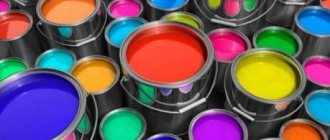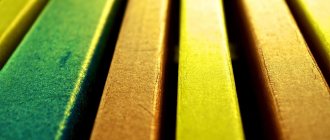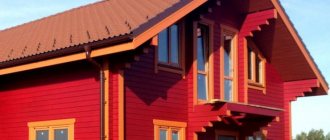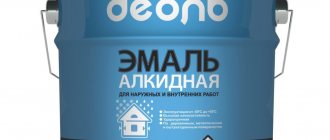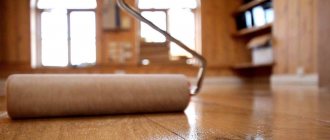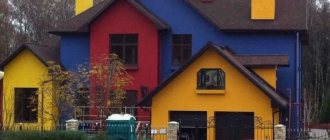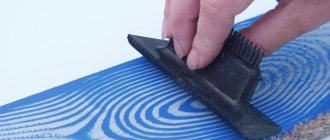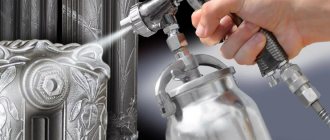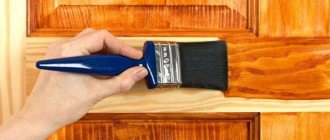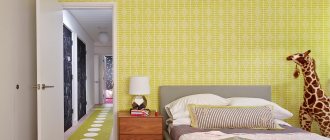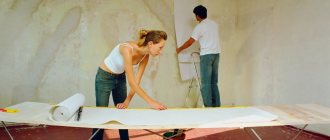Choosing paint for decking boards
Any owner of a summer cottage dreams of adding a wooden veranda to their house. This cozy place becomes the most popular for all family members. After erecting the main structure, it is necessary to paint it. What paint to choose for the terrace to reliably protect the wood from external factors? Today we will try to consider this issue from all sides.
Before you start painting the veranda, you need to prepare the necessary material in advance. There has long been debate about which material is best to use for covering wooden surfaces outdoors. The fact is that open areas made of wood can only be protected for a while, since it is a natural material that is difficult to protect.
What colors are in fashion now?
Currently, natural dark shades are becoming the most popular: brown, dark brown, and especially black or matte black . Despite the seemingly harshness of black, it gives the building nobility and elegance.
It is especially preferable to use black for painting wooden houses that have large white windows or glass verandas and doors. If you don’t like black, you can use equally popular brown or beige and shades closer to lighter tones.
IMPORTANT!
It’s not always worth chasing fashion trends: first of all, the color of the house should bring satisfaction and please the owner’s eye.
Fashion changes much faster than façade painting, so don’t forget about personal preferences and inner feelings.
Main destructive factors
Wood products are constantly under the influence of weather conditions. The structure of this material can easily pass any liquid. The moisture content of wood allows a variety of harmful organisms to develop. As a result, the product begins to rot and disintegrate. In addition, fibers swollen from moisture can begin to destroy the tree from the inside, especially during the cold winter period.
Throughout the year, boards are subject to strong temperature changes. As a result, they change their shape. In this case, not every coating can provide reliable protection against such deformation of the material.
Natural wood is the most breeding ground for many mold fungi. They quickly attack material with a lot of moisture, destroying all the fibers inside with their juices.
Important! There are fungi that can destroy an entire building in a short period of time.
Ultraviolet rays emanating from the sun negatively affect some properties of wooden coatings. They can also ruin the paint, turning it into a faded look.
Wood is very loved by a variety of worms, larvae and other harmful insects. Bark beetles gnaw through many tunnels and eventually eat up the structure. In addition, wood is attacked by mice and rats, which like to settle in summer cottages.
Now we know that there are quite a few enemies near a veranda made of wood. As a result, difficulties arise in caring for this structure. Therefore, it is necessary to find the best option to protect the object from rain, sun, heat and frost.
Choosing material for the veranda
The best option for covering a wooden veranda is paint. However, when choosing this material, you need to pay attention to the fact that you should buy a special paint composition for the floor. To paint the remaining parts of the structure, you can use any paint intended for exterior woodwork.
Coniferous wood is often used in the construction of verandas. They are the most affordable material among tree species. In addition, they have natural protection from water - these are the resins with which the wood is impregnated.
For a coniferous decking board, you will need a significantly smaller amount of paint to cover it.
Acrylic latex paint
This coating has recently become increasingly popular among consumers. It has good reviews about its performance properties. In addition, the paint is easy to work with: it has no odor and is not harmful to health. Manufacturers produce this composition in a huge range of colors and shades.
Scuba diving
Aqualaki today are also popular among summer residents. They are excellent for processing decking boards.
Oil-waxes
This coating is used when they want to preserve the beautiful texture of the wood. However, this composition has one drawback - it is expensive.
I would like to note that all of the above compositions refer to expensive types of coating for wooden surfaces. But their advantage is that they look very beautiful, and they also have the longest service life.
Now we can talk about the floor covering on the terrace. This is a separate issue and quite vulnerable. This building at the dacha bears a heavy load due to the constant influence of unfavorable factors from the outside. And for the floor, such a load increases significantly, so people walk on it in shoes that are often in the swamp, and also the water on the floor does not dry out for a long time, etc.
Useful tips
If you are replacing or laying a new veranda, then it is better to choose boards made from hard wood. They will not wear out, they cost more than soft ones, but their durability and wear resistance are better. If there is a desire to obtain a more pronounced wood texture, the surface is treated with stain before coating with oil.
For the winter, you can cover the floors with polyethylene, so they will be less exposed to temperature changes. To prevent slipping on polyethylene, rubber mats with holes are placed on the path.
If there is a desire to obtain a more pronounced wood texture, the surface is treated with stain before coating with oil.
There are many products on the market that can be used to paint the floor on a veranda at the dacha; half the success of obtaining a durable coating lies in the choice made. Knowing the characteristics of different types should help you choose the best option for painting. The process itself will not take much time and effort; the main thing is not to neglect the surface preparation stage.
Features of the floor
Every year, summer residents have to face such a problem as replacing terrace floor boards. As mentioned earlier, atmospheric conditions can damage even strong coatings. Sometimes wooden floors can be saved by proper installation, which provides a gap of 2-4 mm between the boards.
But even with ideal installation, it is necessary to treat the wood with paints and varnishes to preserve the floor from destruction. They are selected depending on what type of wood the flooring is made of.
Painting a brick house
Is it worth painting the outside of a brick house, since the material itself is noble and noticeable? However, to create accents or to ensure that the building harmonizes with the surrounding landscape, the brick can be repainted. But what color is the best to do it? Most often they try to create a contrast - a bright color will go well with burgundy or brown.
You can also decorate your house in an interesting style by painting individual bricks. It’s a good idea to use contrasting colors to highlight the door or windows. You can also choose paints of different shades for different floors.
Preparing wood for processing
- If the wooden floor has been previously painted, be sure to remove the old paint. In advanced cases, it is recommended to use any solvent for this purpose.
- Before painting wood, all kinds of knots and other defects should be removed. Sometimes the material, after prolonged contact with rain and sun, acquires an unsightly dark color. To get rid of not only defects, but also fungi that have settled in the wood, you need to remove the top layer using a special device.
- Boards that have become unusable must be replaced with new ones, otherwise they will simply crack.
- If, during the period of use of the material, cracks, holes and other gaps appear in it, they need to be sealed with putty and then sanded.
- Before you start covering the boards with a protective substance, the floors must be thoroughly cleaned of dust and foreign objects.
- It is recommended to cover the floors with more than one layer of primer so that the composition saturates the wood well. Complete drying of the material is achieved after three days. And only after that you can start covering the floor with paint or terrace oil.
Step-by-step instruction
First of all, you should discuss the plan for painting the veranda, and then clarify the remaining features regarding this process.
Note! Paint formulations are toxic, so do not eat or drink near open cans. Before starting work, you must ensure that you have a respirator or a special mask, put on gloves, a gown and safety glasses.
Wood skin
Initially, the surface of the boards must be processed using a plane. The top layer must be removed until light wood appears, which will subsequently need to be sanded.
Application of antiseptic
After the previous stage, it is necessary to wash the wood, getting rid of dust, and then let it dry. Only after the wood has completely dried should it be treated with an antiseptic. The composition must be applied to the entire surface and done evenly; special care must be taken to apply the antiseptic to the ends and other hard-to-reach places of the boards.
Primer
It is necessary to allow the antiseptic to completely absorb into the material until it dries completely, after which you can begin priming. It is necessary to prime the surface of the boards, following the instructions given by the manufacturer. Often the primer is applied in two or three layers.
Applying the first layer of finish
Before starting painting, you should thoroughly mix the decking oil, which may have stagnated in the packaging. Some formulations require dilution, but the manufacturer indicates this on the cans.
Floor covering
After completing the preparatory work, we begin the painting process, which should take place in several stages. The first layer of paint can be applied with a roller, and the gaps between the boards can be painted with a brush.
If the tree is being painted for the first time, the paint should be applied in a thin layer and wait for it to dry completely, which can last up to 7 days. There must be at least two such layers, and all of them must be applied in as thin layers as possible. After finishing work, the floor must be rinsed well with warm water.
Source of the article: https://kraska.guru/kraski/vidy/dlya-terrasy.html
Coloring
Painting is carried out in accordance with the instructions for the selected coating. Since wood has a pronounced texture, it is recommended to apply the coating with a brush. The first layer must dry for at least 24 hours. Then you can repeat the painting to achieve a more pronounced color.
It is necessary to observe safety precautions when working with paints and varnishes! For protection you will need a respirator, goggles, gloves and outerwear.
The service life of the coating ranges from 2 to 5 years. Then you just need to tint with the main product, without repeating all the application steps. Then the floor will again be pleasing to the eye, and the wood will be under reliable protection.
Features of operating a terrace or open veranda
Usually the terrace is located at the entrance to the room, so it is used constantly. In the warm season, people are on the terrace almost from morning to evening. Quite often, this part of the home serves as a hallway connecting the street with the rooms, along which people walk in street shoes without taking off their shoes. This circumstance should be taken into account when choosing material for finishing the floor. It should be resistant to abrasion and not deteriorate from frequent cleaning.
The veranda is an open or semi-open room, so it experiences all weather fluctuations. These include daily or seasonal temperature changes, dew, precipitation, and ultraviolet radiation. Under their influence, the wood shrinks or swells, causing stress on the paint layer on it. The wrong material cannot withstand such loads and will crack.
Another aspect that should be taken into account when finishing the veranda is biological. Wood serves as food for some living organisms, such as molds or insect larvae. Larch, often used for cladding, is a tasty morsel for wood-boring beetles. If the boards are not treated with special antiseptic and insect repellent substances, the wood will become a target for mold and pests that destroy it.
How to protect floors, walls, railings and other structural elements made of wood?
Untreated wood of a country house will lose its beauty after the first season. This can happen even with such a resistant material as larch. It will fade in the sun and absorb any dirt. To protect plank floors, lining panels and balusters, they are treated with special materials. Interior parts made of wood should be finished in stages, carefully following the sequence of procedures.
Stages of finishing the veranda:
- impregnation with antiseptic;
- padding;
- painting;
- applying the final layer of wax.
How and with what to properly treat and paint a terrace or veranda?
In order to paint clapboard walls, as well as wooden floors or railings, you will need the following materials and equipment:
- plane (needed to remove the top layer of old wood);
- sandpaper with different grain sizes (used for preliminary sanding);
- brushes, rollers, sprayer (they apply impregnation or paint);
- protective equipment (working clothes, gloves, respirator).
Preparing the structure for work
Before applying the coloring composition, any surface needs pre-treatment. This procedure allows you to make the finish durable and high quality. Preparation stages:
- Removing the top layer with a plane. Sometimes this stage is necessary if you need to refresh an old wood covering that has darkened over time. When working with new material, it is not necessary to plan off the top layer.
- Grinding. It is done using sandpaper manually or mechanically. The boards are sequentially sanded with sandpaper with varying degrees of grain, starting with coarse-grained and ending with fine-grained paper.
- Dry cleaning. Dust, wood particles and abrasive residues are removed using a vacuum cleaner. The gaps between the boards need to be treated especially carefully.
- Bleaching. It is used in the presence of mold or stains of other origin, as well as to lighten old wood. The bleaching method is used to give lumber a white tint.
- Wet cleaning. Before painting, especially contaminated surfaces are washed with water and a brush and dried thoroughly.
How to impregnate wood to protect it from fungus, insects, moisture, fire?
A terrace is a part of the home that is in contact with many environmental factors: sunlight, rain, wind, frost and harmful insects. The wooden cladding of a building needs a coating that would protect it from damaging influences and make it more durable.
The role of such protection is performed by various impregnations. Depending on the composition, they can be fireproof, water-repellent, sunscreen, antifungal, wood-boring beetle repellent, or combine several of these properties.
Examples of impregnations for wooden decking:
- "Tikkurila Euro Valtti Pro". Protects wood from deformation and pests. Emphasizes the color and texture of the boards. The protective effect lasts for 5 years.
- "Neomid 450-1". Fire and bioprotective impregnation with antiseptic effect. Retains its effect from 7 to 10 years.
- "Bug". A product for repelling insects that spoil wood and preventing fungus. Safe for humans. Does not change the color of the wood.
Priming for better adhesion of paintwork to the surface
Before you paint clapboard walls or wood floors, they should be primed. Primer compositions are water-based and organic-based. The group of water-based primers includes acrylic ones, for example, the acrylic universal primer “Areal”. Materials of this type do not smell, do not emit harmful substances and can even be used for finishing glazed verandas.
Primers based on organic solvents are able to penetrate deeper into wood than water-based ones, thanks to small (half the size of water) solvent molecules. An example of such impregnation is “Wood Pro”. The main disadvantage of organic primer mixtures is the strong odor and toxicity during drying. When working with them, ensure good ventilation and use a mask or respirator.
The priming technology depends on the type of product and the instructions supplied with it. The standard method involves applying 2 to 3 coats of primer. Between each application, the primer is allowed to dry for the time prescribed in the instructions. The primer mixture is distributed using a brush or roller with movements directed along the direction of the wood fibers. Work should be carried out at temperatures above +10°C and air humidity less than 80%, in other words, in warm and dry times.
What and how to cover the structure?
On sale you can find several groups of finishing materials that allow you to beautifully treat wooden walls or floors. Such materials include varnishes, paints and special oils. In addition to aesthetic qualities, when purchasing them you need to pay attention to the following parameters:
- wear resistance;
- moisture resistance;
- frost resistance;
- breathability;
- presence of biosecurity;
- safety for people and animals.
Execution of work
Fire-retardant paints for metal Polistil, alas, will not be useful to us.
As always, for those who are planning to work with their own hands, our step-by-step instructions:
We sand the floor to a light shade.
We treat the boards with an antiseptic as thoroughly as possible.
Apply a deep penetration primer with a brush.
Rub in the oil with a brush.
We perform re-processing.
Subsequently, you will only have to repaint the floor every two years.
Important! When treating the floor with antiseptics and fungicides, be sure to use gloves, a gown, safety glasses and a respirator, as the drugs are very toxic and can cause serious poisoning. Smoking or eating while working or in the immediate vicinity of the work area is prohibited, and pets, children and bystanders should also be kept at a safe distance.
